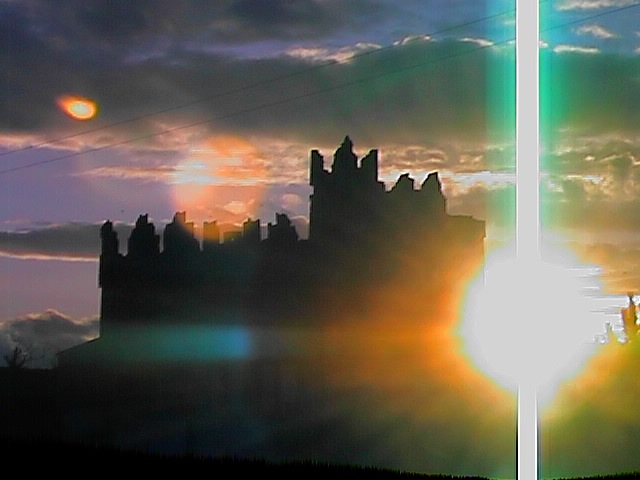 About 40 minutes from Wexford Town is the Barrow valley and it's hidden jewels, such as Graiguenamanagh & St. Mullins, two idyllic spots set in two counties. A favourite drive of mine on a summer's evening.
About 40 minutes from Wexford Town is the Barrow valley and it's hidden jewels, such as Graiguenamanagh & St. Mullins, two idyllic spots set in two counties. A favourite drive of mine on a summer's evening.St. Mullins is a little village just up the Barrow River from New Ross. A cousin of my dad - Trudy Morrell, lived on the Kilkenny or "the Graigue side" high up on the inclines of Brandon Hill looking down upon this scene which you have to concur is a most agreeable sight. Trudy had to move eventually into nearby New Ross, a case of the practical over the romantic as she did not have a car & had to rely on a bus to get to shopping etc.

 Driving from Trudy's home, you arrive in the village of Graiguenamanagh or the Graigue as it's known to the locals, a gorgeous riverside village known for it's abbey and it's cut glass _"Duiske glass". Once you cross the bridge, you're in County Carlow, another picture postcard hamlet that looks pretty driving through but probably is a place that you can't wait to scat from if you're a young local. Here you can hire a boat or a barge and navigate the river up to the canal system or down to Waterford estuary, heading into the Atlantic.
Driving from Trudy's home, you arrive in the village of Graiguenamanagh or the Graigue as it's known to the locals, a gorgeous riverside village known for it's abbey and it's cut glass _"Duiske glass". Once you cross the bridge, you're in County Carlow, another picture postcard hamlet that looks pretty driving through but probably is a place that you can't wait to scat from if you're a young local. Here you can hire a boat or a barge and navigate the river up to the canal system or down to Waterford estuary, heading into the Atlantic. Heading up from Graigue, you drive along a beautiful winding road which has some amazing vistas, very much hidden Ireland. We're in the foothills of the Blackstairs Mountains, rolling up to the wexford border. That is the beauty about The south east of Ireland, a region I consider to be the most beautiful in the country. Having Wexford as it's core stretching across to Waterford's eastern shores, west to the Barrow valley featured here and north to the garden of Ireland - Wicklow.
Heading up from Graigue, you drive along a beautiful winding road which has some amazing vistas, very much hidden Ireland. We're in the foothills of the Blackstairs Mountains, rolling up to the wexford border. That is the beauty about The south east of Ireland, a region I consider to be the most beautiful in the country. Having Wexford as it's core stretching across to Waterford's eastern shores, west to the Barrow valley featured here and north to the garden of Ireland - Wicklow. St. Mullins though takes the biscuit! There is a wonderful serenity to the place that you have to simply experience to believe. It has an impressive ecclesiastical history. The locality takes its name from St. Moling, a 7th century cleric, prince, poet, artist and artisan who built a monastery here with the help of "Gobban Saor", the legendary Irish builder.
St. Mullins though takes the biscuit! There is a wonderful serenity to the place that you have to simply experience to believe. It has an impressive ecclesiastical history. The locality takes its name from St. Moling, a 7th century cleric, prince, poet, artist and artisan who built a monastery here with the help of "Gobban Saor", the legendary Irish builder. 
In the 8th century manuscript, known as “The Book of Mulling”, there is a plan of the monastery, the earliest known plan of an Irish monastery which shows four crosses inside and eight crosses outside the circular monastic wall. It is said that St. Moling dug a mile-long watercourse with his own hands to power his mill – a task that took seven years! He became Bishop of Ferns, died in 697 and is buried at St. Mullin’s.
The St. Moling watercourse is still there, but the original monastery was plundered by the Vikings in 951 and was again burned in 1138. An abbey was built on the site later, in the Middle Ages.
 A 9th century High Cross, depicting the Crucifixion and the Celtic spiral pattern, stands outside the remains of the abbey and there are also some domestic medieval buildings, including one that has an unusual diamond-shaped window. St. Moling's Mill and Well are a short distance away. Another notable monument in the packed little churchyard is a penal altar, used in the days when the anti-Catholic penal laws were in force.
A 9th century High Cross, depicting the Crucifixion and the Celtic spiral pattern, stands outside the remains of the abbey and there are also some domestic medieval buildings, including one that has an unusual diamond-shaped window. St. Moling's Mill and Well are a short distance away. Another notable monument in the packed little churchyard is a penal altar, used in the days when the anti-Catholic penal laws were in force.  A Norman motte, once topped by a wooden castle, stands outside the churchyard, and when Mass was being said at the altar some of the congregation would climb the motte to act as lookouts. Being a Catholic in penal times in Ireland was an offence punishable by death, depending on what mood the travelling magistrate was in. You could not own a horse, own property and as a result vote. No rights basically whatsoever.
A Norman motte, once topped by a wooden castle, stands outside the churchyard, and when Mass was being said at the altar some of the congregation would climb the motte to act as lookouts. Being a Catholic in penal times in Ireland was an offence punishable by death, depending on what mood the travelling magistrate was in. You could not own a horse, own property and as a result vote. No rights basically whatsoever.The MacMurrough Kavanaghs, former Kings of Leinster, together wit h other Celtic Kings, are buried in the neighbourhood of the monastery. A famous "healing priest"Fr. Daniel Kavanagh, is also buried here. People still claim that to cure toothache you should take a pinch of earth from outside the churchyard and exchange it for a pinch of clay from F. Kavanagh's grave. Then say a brief prayer, pop the clay into your mouth and walk down the hill to wash it out with water from St. Molings Well.
h other Celtic Kings, are buried in the neighbourhood of the monastery. A famous "healing priest"Fr. Daniel Kavanagh, is also buried here. People still claim that to cure toothache you should take a pinch of earth from outside the churchyard and exchange it for a pinch of clay from F. Kavanagh's grave. Then say a brief prayer, pop the clay into your mouth and walk down the hill to wash it out with water from St. Molings Well.
 h other Celtic Kings, are buried in the neighbourhood of the monastery. A famous "healing priest"Fr. Daniel Kavanagh, is also buried here. People still claim that to cure toothache you should take a pinch of earth from outside the churchyard and exchange it for a pinch of clay from F. Kavanagh's grave. Then say a brief prayer, pop the clay into your mouth and walk down the hill to wash it out with water from St. Molings Well.
h other Celtic Kings, are buried in the neighbourhood of the monastery. A famous "healing priest"Fr. Daniel Kavanagh, is also buried here. People still claim that to cure toothache you should take a pinch of earth from outside the churchyard and exchange it for a pinch of clay from F. Kavanagh's grave. Then say a brief prayer, pop the clay into your mouth and walk down the hill to wash it out with water from St. Molings Well. The site includes a medieval church ruin, the base of a round tower and the former Church of Ireland church, built in 1811. Protestants and Catholics lie side by side in the churchyard, and a story is told in the village of the days when, because there were only a handful of Protestants in the neighbourhood, the local Church of Ireland Bishop was thinking of closing down the church. The distraught vicar had a word with the Catholic priest, who had a word with his flock, and on the day of the Bishop’s visit Catholic families filled the Protestant church, joining in the responses and lustily singing Protestant hymns. The Bishop went home delighted and the church remained open. I understand they used this story in "The Quiet Man" although it's said that this story is a common one in the South though not in the North - I wonder why.
That's about it for this reminisce of a Barrow Valley drive, Hope you liked the photos.



No comments:
Post a Comment